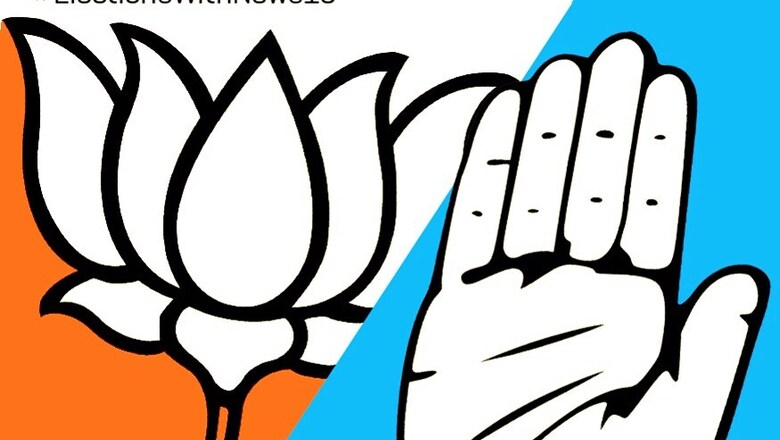
views
New Delhi: Counting of votes in Gujarat is concluding with the BJP winning a narrower victory than it did in 2012. Gujarat had voted in two rounds on December 9 and 14. News18 looks at the five top factors that shaped the outcome of the biggest political battle of 2017.
Patidar Unity
Much of the fight against the ruling BJP has been led by Hardik and his Patidar Anamat Andolan Samiti (PAAS) whose activists have protested, often violently, against the BJP. From flinging chairs at an Amit Shah event to clashing with BJP workers in Surat, Patidars have been the focus of this election. But their “unity” as a singular voting bloc was by no means guaranteed. While it was expected that Hardik’s agitation would lead to a dent in the BJP’s traditional support base — the Patidars — it was unclear just how big a dent this will be. Several key members of Hardik’s inner circle broke away from the agitation to join the BJP. The ruling party’s performance in parts of North Gujarat seems to indicate that the community may not have voted en mass.
The two main sub-castes of the Patidars are the Leuvas and the Kadvas. The Leuva Patels, given their greater number, are more influential electorally, particularly in the Saurashtra region. Perhaps, one of the most significant meetings Hardik had in recent times has been the one with Nareshbhai Patel, Chairman of the Shree Khodaldham Trust, in Rajkot.
The Khodaldham Trust is the apex spiritual and religious body of Leuva Patels – the numerically stronger sub-caste among Gujarat’s Patidars. Hardik belongs to the Kadva Patel community, which forms only about 30% of Patidars. While he enjoys popularity among youth from both subcastes, he knew he required the help of Khodaldham Trust to keep the larger community united.
Some, however, feel that the divide among Patidars was not sub-caste but age. While Hardik Patel has support from younger Patidars, older voters are believed to have voted BJP.
The OBC Factor
OBCs make up 51 percent of Gujarat’s population. Kolis, an OBC community, alone make up around 20%, making them the largest caste group in Gujarat. Patidars make up only around 12%. In several of Gujarat’s 182 seats, the split in the Patidar vote meant OBCs took center stage.
In North Gujarat, where PAAS hoped to mount the toughest challenge to the BJP, OBCs may have emerged as the strongest bloc. Despite activist Alpesh Thakor joining Congress, the BJP was confident of support from North Gujarat’s Thakors, a powerful OBC community. Mehsana district has nearly 4 lakh Patidar voters and Thakors, who form the largest community among the OBCs in Mehsana, have 3.31 lakh voters. Combined with other OBCs, they may have helped the BJP sail through the election. This, perhaps, explains PAAS’s outreach to communities other than the Patels.
‘Gujarat Model’
The election of 2017 has been significant since it was for the first time Prime Minister Narendra Modi’s ‘Gujarat model’ of growth came under such terse criticism in the PM’s home state. What started as a Facebook post by 20-year-old Patidar youth Sagar Savaliya, with the words ‘Vikas Gando Thayo Chhe’ (Vikas has gone crazy), snowballed into a full-fledged social media war with viral memes attacking the BJP.
While the “development” narrative remained mostly missing from the campaign, the BJP did reach out to the state’s voters with a Roll-On/Roll-Off Ferry (RO-RO) between Bhavnagar and Bharuch and Narendra Modi’s Seaplane ride on the last day of campaigning. The last-minute ‘Vikas’ push seems to have worked for the BJP.
BJP’s Tribal Outreach
The reason the BJP is feeling confident, despite the tide of Patidar resentment, is that the saffron party plans to expand its footprint in the tribal belt of South Gujarat. Scheduled Tribes such as Bhils, Vasavas and Gamits make up around 14% of Gujarat’s population. This is a section of society too large for any political party to ignore. Patidars only make up around 12%.
While Adivasis do not exactly vote as one single bloc, they have traditionally remained in the Congress camp. After all, the state’s only Adivasi Chief Minister, Amarsinh Chaudhari, was a Congressman. Meanwhile, the BJP has maintained a steady presence in the region but has always trailed the Grand Old Party.
‘Bapu’
Former Gujarat CM Shnkarsinh Vaghela, who understands North Gujarat better than most in the state, hampered the Congress’s chances severely. North Gujarat is where the battle was said to be most hotly contested and with Vaghela’s spoilers in the fray, the BJP had reason to rejoice. And for Vaghela, a BJP victory is not a high price to pay.
Vaghela, who split from the Congress in July this year and formed the breakaway Jan Vikalp Morcha, is said to be resentful of his former party and planned to damage their chances in North and Central Gujarat. Six districts of North Gujarat – Mehsana, Patan, Banaskantha, Sabarkantha, Aravalli and Gandhinagar – are prestige areas for the BJP and strongholds of the Patidar movement.



















Comments
0 comment